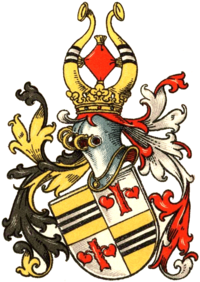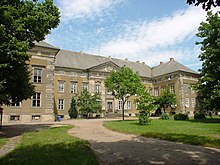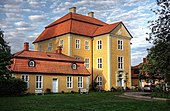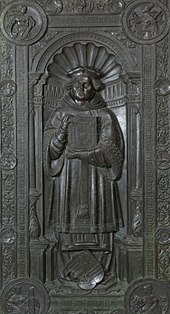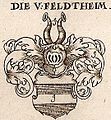Veltheim (noble families)
The following noble families of the name von Veltheim can be distinguished:
A noble family from Veltheim , presumably from Swabia , who settled in the Duchy of Saxony , presumably in Veltheim am Fallstein , around 1068 and appeared between 1157 and 1238 as Counts of Osterburg and Altenhausen . It went out after 1238. It had a coat of arms with three black bars, as has been handed down for a Swabian noble family von Veltheim , which was probably of the same tribe.
In the 13th century, a family (or line) from Veltheim (also with a slightly modified bar coat of arms) to Veltheim near Winterthur in Switzerland was wealthy as ministerials of the Counts of Kyburg . Descent from the same Swabian family also appears possible, but has not been proven.
There is also the original noble Brunswick ministerial family from Veltheim auf Veltheim an der Ohe near Wolfenbüttel, first mentioned in 1141 , which originally had a linden branch in its coat of arms and only took over the bar coat of arms of the now-extinct Counts of Veltheim-Osterburg-Altenhausen in 1391. This family probably does not descend from the noblemen and counts, but may have served them as ministerials. This family is located in Lower Saxony and Saxony-Anhalt and is still blooming in various branches.
Noblemen and Counts of Veltheim and Osterburg
The first mentions of those from Veltheim can be found under the reign of King Henry IV in the late 11th century. It has not been proven that the family settled around what is now Veltheim an der Ohe near Wolfenbüttel and built a moated castle there. Rather, this is to be assumed from the place Veltheim am Fallstein near Osterwieck in the diocese of Halberstadt , already mentioned in 966 , because the last Count Siegfried von Osterburg renounced the churches in Veltheim and Osterode am Fallstein and the tithe in two surrounding villages in 1232 in favor of his liege lord.
According to legend, the family is first mentioned in the region north of the Harz with Ortholph von Veltheim , who is said to have attended the Braunschweig tournament as a guest in 996 . However, there is no evidence of this. Some of the few early representatives of the noble lords of Veltheim that can be documented are named in a document from Halberstadt Bishop Burchard von Veltheim dated July 25, 1087. In addition to the bishop, there are his brother Adalgot von Veltheim and his son Werner von Veltheim ( Velthem ). Burchard and Adalgot were nephews of the Archbishops Anno II of Cologne (also of Swabian-noble-free origin) and Werner von Magdeburg (from the Swabian family of the noble-free von Steusslingen).
Already on August 5, 1068, King Heinrich IV had given Lantfried, who was presumably a brother of Bishop Burchard and Adelgots von Veltheim, 44 Hufen of land in Northern Thuringia and in the Northern March that Burchard had previously owned as a fief. This indicates that the Halberstadt Bishop Burchard was the first of his line to come to Saxony from Swabia and to have his brothers Lantfried and Adalgot follow him. Because the Veltheims from the Harz region had a coat of arms with three black bars, as it has been handed down similarly (with 3 or 2 bars) for the family of the same name, which was based in Swabia and Switzerland.
At that time, the von Veltheim, as feudal bearers of the bishops of Halberstadt, were only noblemen and not yet counts. The aforementioned Werner von Veltheim or his son of the same name is referred to for the first time in a document of the Lippoldsberg monastery with the nobility predicate Graf as Werenherus comes from between 1095 and 1101 , although it is not clear whether this Werner really means a representative of the von Veltheim family . After Brotruff's retrospective narrative “Anhalt. Chronik “took Count Warner to the Osterburch 1108 the daughter Elecke of Count Otto as his wife. With Elecke Adelheid is meant the daughter of Ascanian Otto , Count of Ballenstedt, and sister of the Brandenburg Margrave Albert the Bear . The year 1108 cannot be correct, however, because Adelheid had initially married Heinrich IV, Count von Stade , who as Heinrich II became Margrave of the Nordmark . Only after he died in 1128 can she have married the aforementioned Werner von Osterburg. Werner von Veltheim is not mentioned in a document until October 3rd, 1157 in a document of Albrecht the Bear in the copial book of the Ilsenburg Monastery as comes de Osterburch (= Count of Osterburg), which is what the 2007 850th anniversary of the city of Osterburg referred to. Adalgot is not only the progenitor of the von Veltheim family, but also the Count of Osterburg. The terms Comes de Veltheim and de Osterburg were often used simultaneously in the following years, but recently the name Veltheim was increasingly replaced in favor of Osterburg. In 1170, Count Albrecht von Osterburg founded the Benedictine monastery in Krevese near Osterburg, whose Krevese monastery church has been preserved to this day. The decisive turning point took place in 1238: the last Count Siegfried von Osterburg and Altenhausen renounced most of his goods and he and other representatives of the count's family were no longer mentioned.
Ministerial of Veltheim (Braunschweig)
The 2004 GHdA confirms that there were several independent noble families of Veltheim whose relationship to one another cannot be documented. In addition to the noble lords and counts of Veltheim and Osterburg, there was also the von Veltheim ministerial family in the Braunschweig area from the middle of the 12th century . In 1160 they are first mentioned in a document with this name, which is derived from Veltheim an der Ohe Castle (in the Wolfenbüttel district).
The possibility that these ministerials descend from the knightly class of the counts mentioned above is only a very small one and is based solely on the following consideration:
Count Werner III. von Veltheim had two sons from his marriage to Adelheid von Ballenstedt. The eldest son Werner fell in front of Brandenburg and Count Albrecht continued the family. This marriage may have other children. The Ministeriale Othelricus de Velthem, mentioned in 1141 (1160 and subsequently mentioned as Rotherus de Feltem or similar) could have belonged to this, to whom the ministerial family of the von Veltheim can be traced back. However, this variant is unlikely, as it was very rare in the 12th century that noblemen entered ministerial service and thus relegated to unfree .
The ministerial offices of Veltheim have had the bar coat of arms since 1391, instead of a linden branch that was used up until then. The bar coat of arms, however, was the coat of arms of the Counts of Veltheim and Osterburg. Whether this change of coat of arms was an expression that the ministerials were descended from the now extinct Osterburgers or claimed to be descended from, or because they were once castle men of the Osterburg counts, remains controversial. George Adalbert von Mülverstedt comes to the latter conclusion in his work The Counts of Osterburg and Lüchow . The existing sources on the Brunswick Veltheims in the 13th and 14th centuries have not yet been adequately processed and leave questions unanswered.
The family split into two lines around 1406, when the brothers Hans (“White Line”) and Heinrich (IV.) (“Black Line”) shared “all goods in fiefdoms and inheritance”. The von Veltheim family has had the right to the office of dominatrix of the Marienberg monastery in Helmstedt, as evidenced by Duke Carl I. von Braunschweig-Wolfenbüttel , since 1754 .
After the Second World War , the family was extensively expropriated. She fled to the western occupation zones and lost properties due to the land reform in the Soviet occupation zone , some of which had been in her possession since the Middle Ages, including Harbke (since 1303), Bartensleben (since 1400), the Veltheimsburg in Alvensleben (since 1439) and Ostrau (since 1586), as well as the great Fideikommiss Putbus on Rügen, who had inherited a branch in the 20th century. At the moment branches of the family are still resident on the following Lower Saxon manors: Veltheim an der Ohe (from 1141 to 1494 and again since 1832), Destedt with Cremlingen (since 1356) and Glentorf (since 1420).
Veltheim an der Ohe

The progenitor Othelricus (or Rotherus) de Velthem has been proven to have been seated at Veltheim an der Ohe Castle since it was first mentioned in a document in 1141 .
In the late 15th century, Veltheim Castle was severely damaged by the citizens of Braunschweig who fought to prevent their trade routes to the east. The collection of legal or illegal road tolls flowed into robbery during this time . As a result, Cord von Veltheim sold the destroyed castle to the von Honrodt family around 1494. This ended the story of those from Veltheim in Veltheim an der Ohe for the time being. However, the von Veltheim family stayed on other estates they had acquired in the meantime in the Helmstedt, Magdeburg and Harz region.
The von Honrodt were a noble family from Lower Saxony, which became extinct in the male line in 1814. At times, however, there were family relationships with those of Veltheim, when Heinrich von Veltheim (1644–1696) married Felicitas von Honrodt (1644–1702) adH Veltheim ad Ohe on Alvensleben, Klein-Santersleben and Rottmersleben.
After the von Honrodt family died out, Wilhelm von Veltheim bought the Veltheim an der Ohe family back in 1832. It has been in their possession since then. The farmer Alexander von Veltheim is currently the mayor of Veltheim (Ohe).
Harbke


Between 1303 and 1318, Harbke Castle south of Helmstedt was transferred to that of Veltheim, who owned it until the Soviet troops marched in in 1945.
Between 1573 and 1579 a new palace was built in the Renaissance style. In the middle of the 18th century, the farm buildings were rebuilt in Baroque style, and a French park was created, which is characterized by numerous rare trees and was changed and expanded in the English style in the 19th century. That is why in 1805 Goethe went to Harbke Castle from Helmstedt to meet Mining Captain v. Get to know Veltheim and do botanical studies.
The new rulers failed to renew the damaged roof, so that Harbke Castle, which was still intact in 1945, fell into disrepair in the decades that followed. It is now in ruins. The landscape park was reconstructed.
Harbke also owned Gut Aderstedt am Harz and Gut Groppendorf until 1854 . The Aderstedt manor was owned by the family from 1544 to 1854, and around 1770 they replaced the moated castle there with a baroque manor house. There are still epitaphs of the family in the Aderstedter church. The Romanesque church of St. Marien is located in Groppendorf .
Destedt
The Wasserburg Destedt has been owned by the Veltheims since 1356 . In 1430 and 1432 it was captured by the Brunswick, destroyed and set on fire after being demolished. According to Merian, it is said to have been in ruins for generations.
About two and a half centuries later, after the turmoil of the Thirty Years' War , the owner at the time, Joachim Ludolf von Veltheim, started to rebuild the upper castle. As a result, the current baroque style castle was built in 1693. The Brunswick state master builder Johann Balthasar Lauterbach probably contributed to the design. The castle and estate are still owned by the family today, along with the neighboring Cremlingen manor .
Georg Philipp von Veltheim, Brunswick's court hunter master from 1740, probably laid the foundation for the park in 1750 when he acquired the rectory through land swap. The first trees were planted between 1750 and 1770. After his marriage to Sidonie von Münchhausen , daughter of the botanist Otto von Münchhausen auf Schwöbber , who was known at the time, Johann Friedrich von Veltheim (1731–1800) intended to expand the small French garden west of the palace into an extensive landscape park. From 1768 onwards, the creation of a park began with the help of the gardener from Schwöbber, which was less influenced by English than German ideas. Even today, the complex has some peculiarities, including the predominantly American trees that General Friedrich Adolf Riedesel , Freiherr zu Eisenbach, is said to have sent over from America.
Bartens life
The von Veltheim settled at the moated Bartensleben castle in Bartensleben when Ludolf I von Veltheim came into possession of the castle site in a document on October 18, 1400 through a feudal letter from the Archbishop of Magdeburg . It is also known that one of his successors, Hilmar I. von Veltheim, was enfeoffed with the village of Bartensleben in 1467. The von Veltheims stayed on Bartensleben for over half a millennium until they were expropriated by the land reform in the Soviet occupation zone in 1945.
In the middle of the 18th century they built a baroque palace on the foundations of the former moated castle. In the Bartensleben church there are a total of 35 epitaphs from von Veltheim. There is also a patronage gallery for the family in the church.
After German reunification in 1990, Jobst von Veltheim and his eldest son Nikolaus bought the Bartensleben forest back in 1996. Today Schloss Bartensleben is privately owned and is noticeably deteriorating.
Veltheimsburg in Alvensleben

In 1439, the Veltheims acquired the Margrave Castle at Alvensleben Castle near Haldensleben as a fief from the Archbishops of Magdeburg, after the von Alvensleben family had moved their headquarters to Erxleben Castle around 1270. As the so-called rear castle, it was part of the fortifications and was called "Veltheimsburg" since the middle of the 18th century - presumably to better distinguish it from the main castle Alvensleben, which also belonged to the archbishopric, later Brandenburg's office of Alvensleben.
In the course of a separation, the District Administrator August Wilhelm von Veltheim (1798–1848) was able to acquire the site of the now largely demolished main castle in 1837 and transform it into a landscape park. The buildings of the Veltheimsburg were expanded in a romanticizing way in 1882 and 1910. The Veltheimsburg estate and the castle also remained in Veltheim's possession until they were expropriated by the land reform in 1945.
Ostrau
Around 1586 Achatius von Veltheim is named in Ostrau , who was enfeoffed with Ostrau Castle on February 1, 1586 by Elector August von Sachsen . The Veltheims had the castle converted into a four-wing renaissance castle with a spacious farmyard. During the Thirty Years' War the castle was able to hold out against a Swedish corps under General von Königsmarck and against imperial troops under General Gallas .
Starting in 1713, Otto Ludwig von Veltheim had the old buildings torn down and the French architect Louis Remy de la Fosse built a palace in the French Baroque style, which remained in the family's possession until the expropriation in 1945. It is one of the most valuable baroque buildings in today's state of Saxony-Anhalt . The last owner was the Indologist, anthropologist and world traveler Hans Hasso von Veltheim . With his death without male offspring in 1956, the Ostrau der Line died from Veltheim.
Franz Wilhelm Werner von Veltheim (1785–1839), lord of Ostrau, Kösseln and Großweißandt , had also acquired the Schönfließ estate (Mühlenbecker Land) near Berlin . Werner Freiherr von Veltheim (1843–1919) had a comfortable manor house built there instead of the country house and intensified agriculture - Schönfließer products, especially fresh vegetables, were delivered to the capital. When the investor, Prince Guido Henckel von Donnersmarck , a friend of the emperor, laid out the garden city of Berlin-Frohnau with the landscape architect Ludwig Lesser in 1907 , around 750 hectares of Schönfließer estate were sold. This happened because the entire business was subject to the family entailment rules, with the approval of the family board of those of Veltheim, which was linked to the requirement to buy new space. For this purpose, the Quitzin manor and the Vorwerk Rolofshagen in Western Pomerania were acquired in 1908 . In 1937, the then owner Burghard von Veltheim was forced by the National Socialists to give up the Stolpe business (around 950 hectares) outside Berlin. During this time he was charged with the treachery law as an active member of the professing church . In 1939 he acquired the Üselitz estate with Klein Grabow on Rügen. Quitzin was confiscated after 1943 and eventually housed a in military training camps of the SS . In 1945 he was arrested by the NKVD together with his wife and eight other Schönfließer citizens . He was the only one to be released. His wife and the others were interned in Sachsenhausen concentration camp , where she died in 1946. Burghard von Veltheim was expelled and died in Hamburg in 1951. His grandson Burghard Rübcke-von Veltheim bought together with his wife Friederike, née Freiin von Blomberg , after 1990 essential parts of the Quitzin estate and the Rolofshagen farm as well as some agricultural areas in Schönfließ. Since 2001 he has been suing for the return of the former property due to expropriation due to persecution by the National Socialists .
Other possessions
In 1420 the Veltheim acquired the Glentorf manor near Königslutter. Since then, there has been a branch of the family on this estate to this day.
In the 15th century, Ummendorf Castle was also owned by von Veltheim.
From 1452 to 1457 the Veltheims were briefly masters at Castle Divorce . Bertram, Ludwig and Hans, brothers, sons of Hans III. von Veltheim acquired castle divisions in 1452. However, Bertram von Veltheim sold it on as early as 1457.
At times, the family also owned - in addition to those mentioned above - Altenhausen , Beetzendorf , Beienrode , Erxleben , Helmstedt , Hoggersdorf , Kalbe , Rottmersleben , Klein-Santersleben , Schackensleben , Schönfließ , Stolpe and Üselitz .
Heir to the Putbus family
The Princely House of Putbus on the island of Rügen and the von Veltheim family have been married for four generations: Prince Wilhelm Malte I married the divorced Countess Luise von Veltheim in 1806; their second daughter Asta (1812–1850) married Franz von Veltheim (1812–1874); their daughter Wanda Maria Freiin von Veltheim-Bartensleben married her cousin Wilhelm Malte II in 1857 ; two of their daughters, Marie and Victoria, in turn married two Veltheims. The latter, Viktoria Countess von Wylich and Lottum (1861–1933), heiress of the Lissa Fideikommisses near Breslau, married Ludolf Heinrich von Veltheim in 1888, who then took the name of Veltheim-Lottum . Their son Malte von Veltheim-Lottum (* 1889 † 1945) inherited the inheritance of his maternal grandfather Wilhelm Malte II, Count of Wylich and Lottum , since 1861 Prince and Lord of Putbus , and accepted with the approval of the Reich Minister of the Interior from 20 October 1938 the family name Malte von und zu Putbus on. He died in 1945 in the Sachsenhausen concentration camp.
His son Franz von und zu Putbus (* 1927 - † 2004) lost in 1945 - in addition to the Wylich-Lottumschen property Lissa Castle near Breslau - through the land reform , the property of the Putbus house, which comprised around one sixth of the island of Rügen, and the had previously been placed under compulsory administration by the Nazi government. After reunification in 1990, he unsuccessfully raised claims in court for the restitution of the extensive properties due to the confiscation by the Nazi government. Since 1951 he had the title Prince and Lord zu Putbus , the name was not objected to by the German Nobility Law Committee and his family was entered in the Genealogical Handbook of the Nobility at the Princely Houses (Section III). The Putbus Castle was in 1945 badly damaged and subsequently demolished. However, Franz bought back one of the cavalier houses on the Circus , the circular square in front of the castle, as well as small parts of his lands. His widow, Michaela Fürstin zu Putbus, b. Countess von Carmer, moved to Rügen after his death in 2004 and took over the management of the property, which their son Malte Fürst zu Putbus (* 1964) took over.
Ranks
August von Veltheim (1741–1801) from the Black Line and landlord at Harbke Castle , royal Prussian mining captain, was raised to the Prussian count status in Berlin on July 6, 1798 . On October 15, 1840, the Prussian award of hereditary marshal dignity of the Duchy of Magdeburg in Berlin for Röttger Graf von Veltheim, Majorate Lord of Harbke, Aderstedt and Groppendorf, hereditary kitchen master of the Duchy of Braunschweig.
In recognition of his services for the Duchy of Braunschweig / Lüneburg, Hans von Veltheim (White Line), k. u. k. Lieutenant, raised to the baron status on July 11, 1848. On November 8, 1851, the Austrian prevalence of the title of baron took place for the same.
Veltheim in Switzerland
In Switzerland there was also a von Veltheim family , who derived their name from their seat in Veltheim (city of Winterthur ) (or gave this place their name). The similarity of the coat of arms of the Swiss family with that of the Swabian family is remarkable. A family relationship therefore appears possible. To this day there are bearers of the name "von Felten", which can possibly be traced back to von Veltheim .
coat of arms
Family coat of arms
The coat of arms of the probably originally Swabian von Veltheim family shows a black bar covered with 2 white threads on gold . There are 2 horns in the same colors on the helmet . In Weigel's Wappenbuch from 1734 this drawing of the coat of arms is mentioned with the spelling of Feldtheim for a Swabian family. Thus it can be concluded that the Counts of Veltheim and Osterburg, who had the same coat of arms, were related to them. The Swiss from Veltheim also had a similar coat of arms.
The Braunschweig ministerial offices of Veltheim have had the bar coat of arms since 1391, instead of a branch of linden tree that had been used until then.
Coat of Arms Association
Probably in the 15th or early 16th century there was a union of the arms of the Braunschweigisch-Magdeburg family von Veltheim with that of the family von Samptleben (also Sambeleben , or Samtleben ), who had a trunk with two leaves in the arms. The union with the epitaph of Livinius von Veltheim ( provost of the collegiate monastery of St. Peter and Alexander in Aschaffenburg ) is documented for the first time in the cathedral of St. Maria von Hildesheim , who died around 1531. The use of the new, quartered coat of arms in the year 1563, the year in which it was installed in the church of Burgscheidungen, is clearly documented . Johann Siebmacher shows the new coat of arms in his coat of arms book published in 1605.
The quartered coat of arms shows in fields one and four on silver a sloping red branch with two downwardly curved red leaves and in fields two and three on gold a black bar covered with two white threads. The coat of arms of the Samptleben families shows a pillow on the helmet and a trunk with two leaves in the shield. Both elements can be found in the combined coat of arms.
To this day, the sources do not describe when and why the heraldic union took place. The only evidence is that the von Samptleben family did not die out until 1587. Coats of arms associations usually took place in two cases: In the case of inheritance from one (mostly extinct) family to another; or if a community of descent, i.e. a common root, of two families was suspected (although in earlier centuries such assumptions were handled very generously, so that they are often questioned or refuted in the present, which is more carefully considered in terms of sources). At any rate, a relationship between the two families has not yet been proven in one way or the other.
The tree trunk from the coat of arms of those of Samptleben can also be found in the color green in the modern local coat of arms of Veltheim an der Ohe.
Coat of arms images
(Source: Weigel's Book of Arms from 1734 )
Coat of arms of the Swiss von Veltheim or von Felten family
Well-known namesake
Count of Veltheim-Osterburg
- Adalgot von Veltheim , progenitor of those von Veltheim
- Burchard von Veltheim (around 1028-1088), Bishop of Halberstadt
- Werner I. von Veltheim (around 1100), nephew of Bishop Burchard II. Von Halberstadt
- Adalgod von Osterburg , Count von Veltheim († 1119), Archbishop of Magdeburg from 1107 to 1119
- Rudgar von Veltheim († 1125), Archbishop of Magdeburg from 1119 to 1125
Lords of Veltheim (Braunschweig)
- Heinrich von Veltheim (Hinrik van Velthem), notorious around 1381 for being particularly cruel
- Friedrich Ulrich von Veltheim ( the grim ), member of the Fruitful Society
- Johann Friedrich von Veltheim ( the convalescent ), member of the Fruit Bringing Society
- Heinrich Adrian von Veltheim (1673–1709), Lord of Alvensleben , Rottmersleben , Lut.-Santersleben and Schackensleben
- Adrian Friedrich von Veltheim (1710–1765), Major General of the Electorate of Hanover and commander of a dragoon regiment (incorrectly also: Adrian Dietrich )
- Carl August von Veltheim (1718–1781), lieutenant general of the Electorate of Hanover
- Count August von Veltheim (1741–1801), mining captain, mineralogist
- Johann August von Veltheim (1754–1829), officer in the British service ( King's German Legion ) and lieutenant general in the Kingdom of Hanover
- Franz von Veltheim (1785–1839), Prussian chief miner
- Karl Friedrich (called Fritz) (1824–1896), President of the Brunswick State Assembly, member of the Regency Council
- Charlotte von Veltheim (1832–1911), domina of Marienberg Abbey , co-founder of the Lower Saxony Parament Association and founder of the Helmstedt district hospital in St. Marienberg
- Werner von Veltheim (1843-1919), castle captain of Königs Wusterhausen
- Hans-Hasso von Veltheim (1885–1956), travel writer and anthroposophist
- Malte von Veltheim -Putbus (1889–1945), large landowner
- Ludolf von Veltheim (1924–2007), farmer and sports official
See also
literature
- Georg Schmidt : Pedigree of Veltheim . In: German Herald. 45 (1914).
- Georg Schmidt: The family of Veltheim. 2 vols. Halle 1912.
- Fritz von Veltheim: Collection of documents from the Counts and Nobles von Veltheim family from 950 to 1500. Destedt 1934. (Manuscript)
- Fritz von Veltheim: The family of Veltheim. Destedt 1943.
Web links
Individual evidence
- ^ Document book of the Halberstadt monastery, document before December 31, 1232
- ↑ Veltheim, one family. In: Johann Heinrich Zedler : Large complete universal lexicon of all sciences and arts . Volume 46, Leipzig 1745, column 1078-1083.
- ↑ Eduard Jacobs : Document book of the Ilsenburg Monastery, p. 8, No. 7
- ↑ 6 DH IV. 207; UBHH I, 99, p. 67.
- ↑ Karl Meyer: Die Graf von Hohnstein , in: Zeitschrift des Harzverein für Geschichte und Altertumskunde 28 (1895), p. 400. There, quoted from Heinemann, CDA I, no. 162
- ↑ Brotruff Anhalt. Chron. L. 1 p. 23; Becmann Anhalt. History part 4, L 1 c 5
- ^ Heinrichsen: South German noble families in Lower Saxony. P. 71 ff.
- ↑ GHdA Noble Houses A Volume XVII, 1993
- ↑ Horst-Rüdiger Jarck, Günter Scheel (ed.): Braunschweigisches Biographisches Lexikon. 19th and 20th centuries. P. 624.
- ^ Veltheim on Braunschweig-Touren.de
- ↑ Worldhistory.de
- ↑ FOCUS No. 42 (1997) Putbus-Erbe - Considerable doubts
- ↑ Genealogy Putbus
- ↑ Weigel's Book of Arms from 1734, Part V, Plate 207
- ↑ Jahrzeitenbuch Schönenwerd (original in the State Archives), printed in the Urkundio
- ^ Johann Siebmacher : Siebmacher's Wappenbuch , 1605, Saxony sheet 167
- ↑ Ludwig Hänselmann, Chron. D. Nieds. Cities, Braunschweig, 1868, vol. 1 p. 68f. / as before: Braunschweig in the everyday guerrilla warfare of the Middle Ages - work pieces vol. 1, Wolfenb. 1887.
- ↑ Joachim Lehrmann : Fricke van Twedorp / von Zweydorff - From the life of a patrician and cymbal entrepreneur in the Braunschweiger Neustadt - around 1400. In: Braunschweigische Heimat, 2016, pp. 8-19.
- ^ Schmidt, Georg (1912): The Veltheim family , Chapter 10 , pp. 271-274



